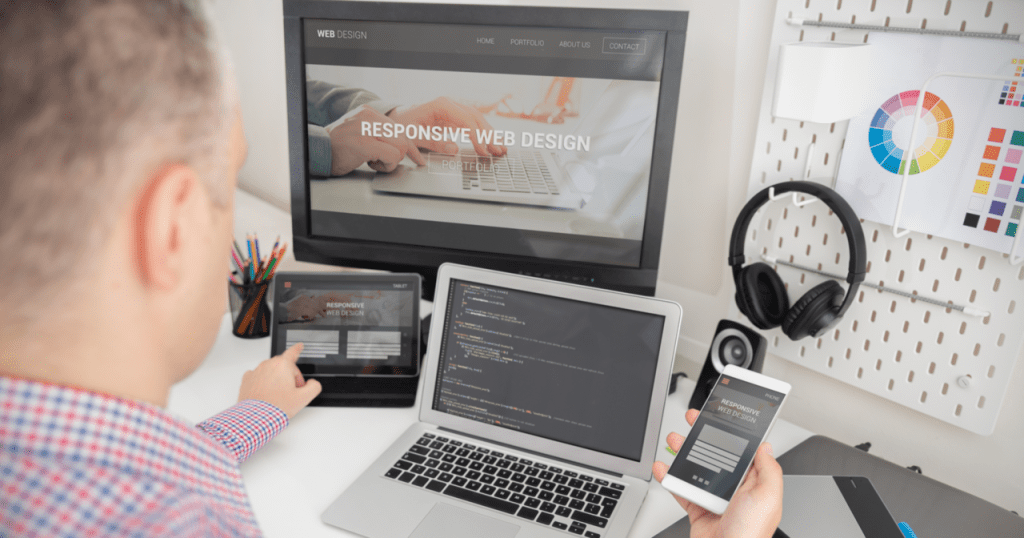
Product Page Design Best Practices to Increase Conversions
Introduction: Why Product Page Design Matters
Your product page is where browsers become buyers—or abandon their carts forever. Research shows that 70% of online shopping carts are abandoned, with poor product page design being a leading contributor. A well-designed product page can increase conversion rates by up to 200%, making it one of your most valuable business assets.
Product page design best practices aren’t just about aesthetics—they’re about creating seamless user experiences that guide visitors toward purchase decisions. Every element, from product images to call-to-action placement, plays a crucial role in converting interest into sales.
For e-commerce businesses in Kerala and beyond, understanding these design principles can mean the difference between thriving online stores and struggling websites that fail to capture their market potential.
Key Elements of a High-Converting Product Page
Essential Components That Drive Sales
Product Title and Description: Your product title should be clear, descriptive, and include relevant keywords for SEO-friendly product pages. The description must address customer pain points while highlighting key benefits and features.
High-Quality Product Images. Visual content accounts for 65% of purchase decisions. Multiple high-resolution images, zoom functionality, and 360-degree views have a significant impact on conversion rates.
Pricing and Availability: Display pricing prominently with clear inventory status. Include any discounts, promotions, or bulk pricing options to create urgency and value perception.
Call-to-Action Buttons Strategic call-to-action placement with compelling copy like “Add to Cart,” “Buy Now,” or “Get Yours Today” guides users toward conversion.
Trust Signals: Customer reviews, security badges, return policies, and guarantees build confidence and reduce purchase anxiety.
Best Practices for Product Page Layout & Design
Creating an E-commerce Product Page Layout That Converts
Above-the-Fold Optimization: Place critical information—product name, main image, price, and primary CTA—within the first viewport. Users should understand your offering within 3 seconds of landing on the page.
Visual Hierarchy Use size, color, and spacing to guide the eye through your content logically. The most important elements should be the most prominent.
White Space Utilization Clean, uncluttered designs reduce cognitive load and help users focus on key information. Don’t cram every detail above the fold.
Consistent Branding: Maintain brand colors, fonts, and styling throughout the product page to reinforce trust and professionalism.
Information Architecture
Organize product details in scannable sections:
- Key features and benefits
- Technical specifications
- Shipping and return information
- Customer reviews and ratings
- Related or recommended products
Optimizing for Mobile Shoppers
Mobile Responsive Product Pages Are Non-Negotiable
Mobile commerce accounts for over 54% of e-commerce traffic. Your mobile product page optimization should prioritize:
Touch-Friendly Design Buttons and interactive elements should be at least 44×44 pixels with adequate spacing to prevent accidental taps.
Simplified Navigation: Reduce menu options and streamline the path to purchase. Mobile users want quick, efficient experiences.
Fast Loading Spee:d Compress images and minimize code to achieve loading speeds under 3 seconds. Every second of delay can reduce conversions by 7%.
Thumb-Friendly Layout Position important elements within easy thumb reach on smartphone screens. The bottom third of the screen is prime real estate for CTAs.
Visuals That Sell: Images, Videos & Galleries
Product Image Best Practices That Drive Conversions
Multiple Angles and Views Provide at least 5-7 high-quality images showing different angles, close-ups of details, and the product in use.
Consistent Image Standards Use consistent backgrounds, lighting, and dimensions across all product photos to maintain a professional appearance.
Zoom and Interactive Features Enable image zoom functionality and consider 360-degree product views for complex items. Interactive galleries increase engagement by 40%.
Lifestyle and Context Images Show products being used in real situations to help customers visualize ownership and usage.
Video Content Product videos can increase purchase likelihood by 85%. Include unboxing videos, demonstrations, or customer testimonials.
The Role of CTAs: Placement, Design & Copy
Strategic Call-to-Action Placement for Maximum Impact
Primary CTA Positioning: Place your main “Add to Cart” button above the fold and repeat it after product details. Use contrasting colors that stand out from your design palette.
Action-Oriented Copy Use specific, benefit-driven language:
- “Add to Cart” (clear and direct)
- “Get Free Shipping” (value-focused)
- “Buy Now – Limited Stock” (urgency-driven)
Visual Design Elements Make CTAs prominent with:
- High contrast colors
- Adequate button size (minimum 44px height)
- Clear, readable typography
- Subtle animations or hover effects
Secondary CTAs include options like “Save for Later,” “Add to Wishlist,” or “Share” to capture users who aren’t ready to purchase immediately.
Trust Signals: Reviews, Security Badges & Guarantees
Building Confidence Through Trust Signals for E-commerce
Customer Reviews and Ratings: Display authentic customer reviews prominently. Products with reviews see 270% higher purchase rates than those without.
Security and Payment Icons Show SSL certificates, payment processor logos, and security badges near checkout areas to reduce cart abandonment.
Return and Refund Policies Clear, generous return policies can increase conversions by up to 30%. Make these policies easily accessible.
Social Proof Elements Include testimonials, user-generated content, and social media mentions to demonstrate product popularity and satisfaction.
Company Information Display contact information, business address, and customer service hours to establish legitimacy and accessibility.
SEO Tips for Product Pages
Optimizing Product Pages for Search Visibility
Title Tag Optimization: Include primary keywords in title tags while keeping them under 60 characters. Format: “Product Name | Brand – Key Benefit”
Meta Descriptions Write compelling meta descriptions (150-160 characters) that include keywords and encourage clicks.
Header Structure Use H1 for product names and H2-H3 for features, specifications, and reviews to create a clear content hierarchy.
Image Alt Text: Include descriptive alt text for all product images to improve accessibility and image search rankings.
Schema Markup Implement product schema markup to enhance search result appearance with rich snippets showing price, availability, and ratings.
Mistakes to Avoid in E-commerce Product Design
Common Pitfalls That Kill Conversions
Information Overload: Don’t overwhelm users with excessive details above the fold. Prioritize the most important information and use progressive disclosure for additional details.
Poor Image Quality, resolution, inconsistent, or poorly lit product images immediately reduce credibility and purchase intent.
Hidden Cost:s Surprise shipping charges or fees at checkout are the #1 reason for cart abandonment. Be transparent about all costs upfront.
Weak Product Descriptions: Generic, feature-only descriptions don’t sell. Focus on benefits, use sensory language, and address customer concerns.
Complicated Checkout Process Long, multi-step checkout processes increase abandonment rates. Simplify wherever possible and offer guest checkout options.
How Bethelsoft Helps E-commerce Businesses Succeed
Expert Web Design Services in Kerala
At Bethelsoft, we understand that effective UX design for online stores requires both technical expertise and a deep understanding of consumer psychology. Our team specializes in creating high-converting product pages that combine aesthetic appeal with conversion optimization principles.
Our Product Page Design Services Include:
- Comprehensive UX audits and optimization recommendations
- Mobile-first responsive design implementation
- A/B testing for CTA placement and design elements
- SEO optimization for improved search visibility
- Integration of trust signals and social proof elements
- Performance optimization for faster loading speeds
As a web design company, we’ve helped numerous e-commerce businesses increase their conversion rates through strategic product page redesigns. Our data-driven approach ensures every design decision contributes to your bottom line.
Whether you’re launching a new online store or optimizing existing product pages, our team brings the expertise needed to transform browsers into buyers.
Conclusion: Start Converting More Visitors Today
Implementing these product page design best practices can dramatically improve your e-commerce conversion rates. Remember that successful product page optimization is an ongoing process requiring regular testing, analysis, and refinement.
The key is to focus on user experience while strategically incorporating elements that build trust and encourage action. Every detail matters—from image quality to CTA copy to mobile responsiveness.
Ready to transform your product pages into conversion machines? Contact Bethelsoft today for a comprehensive audit of your e-commerce site. Our team of UX specialists and web designers will help you create product pages that not only look great but also drive real business results.
Let’s work together to maximize your online store’s potential and turn more visitors into loyal customers.
